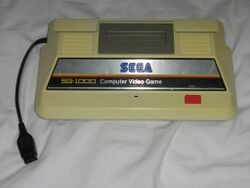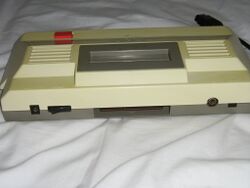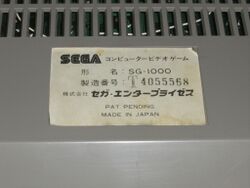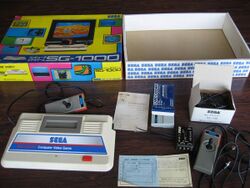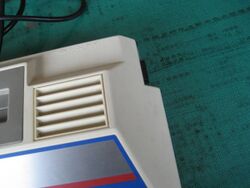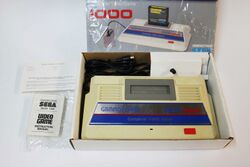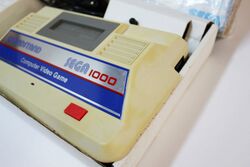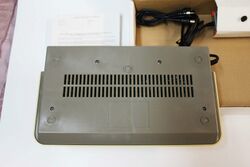Difference between revisions of "SG-1000"
From Sega Retro
| Line 15: | Line 15: | ||
}} | }} | ||
}} | }} | ||
| − | The '''SG-1000''' ('''Sega Game 1000'''), known in New Zealand as the '''Sega 1000''', is a cartridge-based video game console released in 1983 by [[Sega]]. It stands as Sega's first entry into the video game console market, and though was not seen as a huge success, gave the company more experience when dealing with future systems. It is now a rare and often sought after console. | + | <section begin=intro />The '''SG-1000''' ('''Sega Game 1000'''), known in New Zealand as the '''Sega 1000''', is a cartridge-based video game console released in 1983 by [[Sega]]. It stands as Sega's first entry into the video game console market, and though was not seen as a huge success, gave the company more experience when dealing with future systems. It is now a rare and often sought after console. |
| − | The SG-1000 sold about 2 million units worldwide.{{ref|1=[http://books.google.co.uk/books?id=6CS7AAAAIAAJ&q=sg-1000 Co-opetition (Page 238)]}} Its computer counterpart, released during the same period, is the [[SC-3000]]. There is also [[SG-1000-based arcade hardware]]. It had an improved version, the [[SG-1000 II]], and was succeeded by the [[Sega Mark III]], which was released worldwide as the [[Sega Master System]]. | + | The SG-1000 sold about 2 million units worldwide.{{ref|1=[http://books.google.co.uk/books?id=6CS7AAAAIAAJ&q=sg-1000 Co-opetition (Page 238)]}} Its computer counterpart, released during the same period, is the [[SC-3000]]. There is also [[SG-1000-based arcade hardware]]. It had an improved version, the [[SG-1000 II]], and was succeeded by the [[Sega Mark III]], which was released worldwide as the [[Sega Master System]].<section end=intro /> |
==Hardware== | ==Hardware== | ||
Revision as of 11:21, 25 February 2017
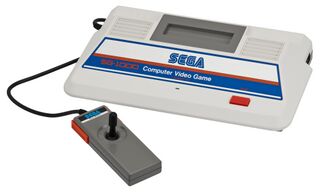
| ||||||||||||||||||||
| SG-1000 | ||||||||||||||||||||
|---|---|---|---|---|---|---|---|---|---|---|---|---|---|---|---|---|---|---|---|---|
| Manufacturer: Sega | ||||||||||||||||||||
| Variants: SG-1000 II, Othello Multivision, SC-3000, Pioneer TV Video Game Pack SD-G5, SG-1000-based arcade hardware | ||||||||||||||||||||
|
The SG-1000 (Sega Game 1000), known in New Zealand as the Sega 1000, is a cartridge-based video game console released in 1983 by Sega. It stands as Sega's first entry into the video game console market, and though was not seen as a huge success, gave the company more experience when dealing with future systems. It is now a rare and often sought after console.
The SG-1000 sold about 2 million units worldwide.[3] Its computer counterpart, released during the same period, is the SC-3000. There is also SG-1000-based arcade hardware. It had an improved version, the SG-1000 II, and was succeeded by the Sega Mark III, which was released worldwide as the Sega Master System.
Hardware
The SG-1000 is a top-loading cartridge based video game console with a white and grey plastic finish. Compared to many other systems from around this era the SG-1000 sports a relatively simplistic design - a power switch, RF output and expansion port on the back, and a red pause button at the front.
The first controller (a SJ-200) is hard-wired into the unit and cannot be easily removed; however, a second controller can be connected through a DE-9 port on the right-hand side of the unit. Sega later released an adapter cable (known as the JC-100) that allowed for the use of standard detachable controllers and replaced the hard-wired joystick.
Internally, the SG-1000 has largely identical hardware to the ColecoVision, but with the SG-1000 having a faster VRAM chip (by Fujitsu). The similarities explain why the Telegames Personal Arcade is compatible with both the ColecoVision and SG-1000, and how in recent years a number of SG-1000 games have been unofficially ported to the ColecoVision (such as Doki Doki Penguin Land and Girl's Garden).
Its computer counterpart, the SC-3000, is identical in hardware, but with the SC-3000 having more program RAM. It was roughly on par with the original MSX standard, which was largely identical in hardware, but with more program RAM than both the SG-1000 and SC-3000. In Taiwan and South Korea, several MSX games have been ported to the SG-1000.
The SG-1000 is a much flatter console than people expect - its odd shape and aesthetics give the impression that it is a taller system than it actually is.
Controls were an issue for the SG-1000 - the SJ-200 is often criticised for being stiff and unresponsive, and should it break, there is no easy way to replace it. All future consoles by Sega would allow both controllers to be removed.
The SK-1100 keyboard is designed to be plugged into the back of the SG-1000, bringing the unit closer to the offerings of the SC-3000.
The SG-1000 and SC-3000 were roughly on-par with the original MSX standard, and generally more powerful than the Commodore 64, the most powerful Western computer in the early '80s (see SC-3000: Hardware). However, they were not as powerful as rival Nintendo's Famicom/NES.
Models
- Main article: SG-1000 consoles.
Black stripe model
Early models in Japan had black labels and a slightly different logo (sometimes referred to as the "German Model" due to similarities with the German flag), but these are a considerably rarer sighting.
Blue stripe model
Unlike the early "German Model", the second, and most commonly found, model features a blue label rather than black.
Sega 1000
The model released in New Zealand, was renamed to "Sega 1000" and resembles the second Japanese model, with a blue stripe and the addition of Grandstand's name.
Technical specifications
CPU
Graphics
- Graphics chip: Texas Instruments TMS9918A[4]
- Screen resolution: 256×192 pixels[7]
- Overscan resolution: 342x262 (NTSC), 342x313 (PAL)
- Refresh rate: 59.922743 Hz (NTSC), 49.701459 Hz (PAL)
- Frame rate: 59.922743 FPS (NTSC), 49.701459 FPS (PAL)
- Color palette: 16 colors (15 colors + transparent),[8][7] all on screen
- Programmable limit: 105 color palette (all on screen) possible with static image[9]
- Sprites: 2 colors per sprite, 8-32 bytes per sprite[7]
- Sprites on screen: 32 sprites on screen, 64 sprites with programming tricks,[10][11] 64-256 sprite tiles on screen
- Hardware sprites per scanline: 4 sprites per scanline, 20 sprites per 21 scanlines[12]
- Flickering sprites per scanline: 9 sprites per scanline[13]
- Sprite pixel sizes: 8×8 or 16×16 pixels (32-64 sprite pixels per scanline)
- Integer sprite zooming: Up to 32×32 pixels, sprites can be programmed to reduce size (saving scanline bandwidth)[12]
- Background: Tilemap playfield, 8×8 tiles, 2 colors per tile, 8 bytes per tile[7]
- VRAM: Fujitsu MB8118-12 page mode DRAM,[16] 16 KB, 832-1024 tiles[7]
- Sprite attribute table: 128 bytes (4 bytes per sprite)
- Sprite tiles: 2 KB (64-256 tiles, 8-32 bytes per tile)
- Background tiles: 6 KB (768 tiles, 32×24 tiles, 256×192 pixels, 8 bytes per tile)
- VDP display modes:[17]
- Modes 1–2: 256x192 resolution, tilemap, 2 colors per tile, 8 bytes per tile
- Mode 3: 64×48 resolution, bitmap, 16 colors per pixel, 4-bit per pixel
- VRAM bandwidth:
- Pixel fillrate:
- Read fillrate: 5.3693175 MPixels/s (NTSC), 5.3203424 MPixels/s (PAL)
- Mode 1-2 write fillrate: 1-bit per pixel, 2.386363 MPixels/s (NTSC), 2.364595 MPixels/s (PAL)
- Mode 1-2 write during active display: 1.398352 MPixels/s (NTSC), 1.448896 MPixels/s (PAL)
- Mode 3 write fillrate: 4-bit per pixel, 596,590 pixels/s (NTSC), 591,148 pixels/s (PAL)
- Mode 3 write during active display: 349,588 pixels/s (NTSC), 362,224 pixels/s (PAL)
- Tile fillrate: 8 bytes per tile
- Read fillrate: 83,895 tiles/sec (NTSC), 83,130 tiles/sec (PAL)
- Write fillrate: 37,286 tiles/sec (NTSC), 36,946 tiles/sec (PAL)
- Write during active display: 21,849 tiles/sec (NTSC), 22,639 tiles/sec (PAL)
Sound
- Sound chip: Texas Instruments SN76489A[4]
- Clock rate: 3.579545 MHz[4]
- 4 channel mono sound[20]
- 3 square wave sound generator channels, 4 octaves each[20]
- 1 white noise generator channel[20]
Memory
History
The SG-1000 was first released to the Japanese market in July 1983 for ¥15,000. It was a minor success for Sega, but was held back from the start due to sharing the same release date as the Nintendo Famicom. It is rumoured to have been test marketed as early as 1981, being kept in stasis while kinks were ironed out in certain SC-3000 utility software.
Despite having some initial support from the likes of Konami, the console was largely abandoned by 1985, though staggered on to the late date of 1987 with The Black Onyx as the last official Japanese release.
In Japan the SG-1000 initially saw competition in the form of the likes of Epoch, Tomy, Takara, Bandai, Casio and Nichibutsu, all of which were wiped off the market by the Famicom's success. The SG-1000 fared much better than all of these systems, mostly due to a library of Sega-exclusive arcade games brought to the system though was never able to maintain a dominant position in the market. Furthermore, its computer counterpart, the SC-3000, contained all the features of the SG-1000 and more, and therefore made a considerable dent in SG-1000 sales.
The only known release outside of Japan for the original SG-1000 model was New Zealand where it was distributed and badged by Grandstand. Neither the console or any of its official variants ever reached North America, however the SG-1000 compatible Dina 2 in one was released in the US by Telegames. The SC-3000 was released in Australia (John Sands), New Zealand (Grandstand), France (ITMC), Italy (Melchioni), and Finland (Digital Systems). As a result, the SG-1000 likely stands as Sega's worst performing video game console on record in terms of units sold, but Sega likely still profited from the venture.
In July 1984, Sega released an updated version of the console called the SG-1000 II, which moved the rear expansion port to the front of the system (used for the SK-1100 keyboard) and updated the controllers with an appearance similar to that of the Famicom. Outside of Japan the SG-1000 II is only known to have made it to Taiwan where it was distributed and badged by Aaronix.
Sega were very experimental during the early days, licensing game manufacturer Tsukuda Original with the rights to produce the Othello Multivision, an SG-1000 clone. An early plan of action seems to have been to create a computer game standard, allowing companies to focus more on games than on hardware - something which later be realised in Japan with the MSX, at the expense of the SG-1000.
Bit Corp produced the Dina 2 in one SG-1000 clone, likely without a license, which also had the ability to run ColecoVision games. In North America this was distributed by Telegames as the Telegames Personal Arcade. The SG-1000 was also released in "module" form as the Pioneer TV Video Game Pack SD-G5.
Ultimately all SG-1000/SC-3000 variations failed to capture the market share Sega had been aiming for, leading to the creation of the Sega Mark III, another revision of the hardware in Japan with improved video hardware and an increased amount of RAM. This would later be the basis of the Sega Master System, and both the Japanese Mark III and Master System are backwards compatible with the SG-1000. Many unlicensed Master System games run in the mode intended for SG-1000 compatibility, and are therefore, in a sense, SG-1000 games.
Games
List of games
- Main article: List of SG-1000 games.
SG-1000
- Bank Panic (1985)
- The Black Onyx (1987)
- Bomb Jack (1985)
- Borderline (1983)
- The Castle (1986)
- Chack'n Pop (1985)
- Champion Baseball (1983)
- Champion Billiards (1986)
- Champion Boxing (1984)
- Champion Golf (1983)
- Champion Ice Hockey (1985)
- Champion Kendou (1986)
- Champion Pro Wrestling (1985)
- Championship Lode Runner (1985)
- Champion Soccer (1984)
- Champion Tennis (1983)
- Choplifter (1985)
- Congo Bongo (1983)
- C_So! (1985)
- Doki Doki Penguin Land (1985)
- Dragon Wang (1985)
- Drol (1985)
- Elevator Action (1985)
- Exerion (1983)
- Flicky (1984)
- Girl's Garden (1984)
- Golgo 13 (1984)
- GP World (1985)
- Gulkave (1986)
- Hang On II (1985)
- H.E.R.O. (1985)
- Home Mahjong (1984)
- Hustle Chumy (1984)
- Hyper Sports (1985)
- Lode Runner (1984)
- Loretta no Shouzou: Sherlock Holmes (1987)
- Mahjong (1983)
- Monaco GP (1983)
- Ninja Princess (1986)
- N-Sub (1983)
- Orguss (1984)
- Othello (1985)
- Pacar (1983)
- Pachinko (1983)
- Pachinko II (1984)
- Pitfall II: The Lost Caverns (1985)
- Pop Flamer (1983)
- Rock n' Bolt (1985)
- Safari Hunting (1983)
- Safari Race (1984)
- Sega Flipper (1983)
- Sega Galaga (1983)
- Serizawa Hachidan no Tsumeshogi (1983)
- Shinnyuushain Tooru-Kun (1985)
- Sindbad Mystery (1983)
- Soukoban (1985)
- Space Armor (1984)
- Space Invaders (1985)
- Space Slalom (1983)
- Star Force (1985)
- Star Jacker (1983)
- Super Tank (1986)
- Terebi Oekaki (1986)
- Wonder Boy (1986)
- Yamato (1983)
- Zaxxon (1985)
- Zippy Race (1983)
- Zoom 909 (1985)
Othello Multivision
- 007 James Bond (1984)
- Challenge Derby (1984)
- Guzzler (1983)
- Okamoto Ayako no Match Play Golf (1984)
- Q*bert (1983)
- San-nin Mahjong (1984)
- Space Mountain (1984)
Cancelled titles
- Challenge Soccer
- Champion Ski
- Great Escape 2 (Othello Multivision)
- Up'n Down
- Yie Ar Kung-Fu
Promotional material
JP TV advert
JP advert with SK-1100 (1984)
Artwork
References
- ↑ SG-1000: Data (Sega) (Wayback Machine)
- ↑ SG-1000 (Sega) (Wayback Machine)
- ↑ Co-opetition (Page 238)
- ↑ 4.0 4.1 4.2 4.3 4.4 4.5 4.6 MAME's SG-1000 driver
- ↑ Obsolete Microprocessors
- ↑ File:SC-3000ServiceManual.pdf, page 16
- ↑ 7.0 7.1 7.2 7.3 7.4 Sega Game 1000 (SG-1000) Information (Draft)
- ↑ TMS9918
- ↑ TMS9918 test (AtariAge)
- ↑ MSXdev'14 - Uridium announced (MSX Research Center)
- ↑ 64 sprites on screen (MSX Research Center)
- ↑ 12.0 12.1 New sprite record (MSX Research Center)
- ↑ Coleco graphics capacity (AtariAge)
- ↑ A guide to scrolling game engines on MSX
- ↑ MSX1 Games with smooth scroll (MSX Resource Center)
- ↑ 16.0 16.1 File:MB8118 datasheet.pdf
- ↑ Sega Master System VDP documentation (2002-11-12)
- ↑ 18.0 18.1 18.2 File:SC-3000ServiceManual.pdf, page 12
- ↑ Bytes written to VRAM per frame
- ↑ 20.0 20.1 20.2 SN76489
- ↑ SG-1000 (Sega)
- ↑ File:SC-3000ServiceManual.pdf, page 15
- ↑ Service Games: The Rise and Fall of SEGA: Enhanced Edition, page 17
- ↑ File:MB8118 datasheet.pdf, page 3
| Sega SG-1000 Hardware | |
| SG-1000 Variations | SG-1000 | SG-1000 II | SC-3000 | SC-5000 | Othello Multivision | Pasocom Gakushuudzukue | SD-G5 | Arcade |
|---|---|
| Add-ons | Super Control Station SF-7000 | 4 Color Plotter Printer | Data Recorder SR-1000 | Sega Keyboard |
| Game Controllers | Joystick (SJ-200) | Joystick (SJ-300) | Joypad (SJ-150) | SJ-151 | Handle Controller | Bike Handle | Sega Graphic Board | Pasoko-1000 |
| Misc. Hardware | Card Catcher | Extension Cable Kit (JC-100) | SD-80 | Sega Compact Floppy Disk |
| Unlicensed Clones | Dina 2 in one | Fullwis Video Game FR-II |
| Sega Home Video Game Systems | ||||||||||||||||||||||||||||
| 83 | 84 | 85 | 86 | 87 | 88 | 89 | 90 | 91 | 92 | 93 | 94 | 95 | 96 | 97 | 98 | 99 | 00 | 01 | 02 | 03 | 04 | 05 | 06 | 07 | 08 | 09 | 10 | 11 |
|---|---|---|---|---|---|---|---|---|---|---|---|---|---|---|---|---|---|---|---|---|---|---|---|---|---|---|---|---|
| SG-1000 | SG-1000 II | Mega Drive | Mega Drive II | |||||||||||||||||||||||||
| SC-3000 | Mega-CD | Mega-CD II | Genesis 3 | |||||||||||||||||||||||||
| Sega Mark III | 32X | Dreamcast | ||||||||||||||||||||||||||
| Master System | Master System II | |||||||||||||||||||||||||||
| AI Computer | Game Gear | |||||||||||||||||||||||||||
| Saturn | ||||||||||||||||||||||||||||
| Pico | Beena | |||||||||||||||||||||||||||
